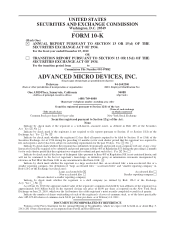AMD 2010 Annual Report Download - page 15
Download and view the complete annual report
Please find page 15 of the 2010 AMD annual report below. You can navigate through the pages in the report by either clicking on the pages listed below, or by using the keyword search tool below to find specific information within the annual report.Graphics Products
Graphics Market
The primary product of a semiconductor graphics supplier is the GPU. The GPU is specifically architected
for high performance graphics processing, unlike the CPU. In this way, a dedicated GPU and CPU work in
tandem to increase overall speed and performance of the system. A graphics solution can be in the form of either
a discrete GPU, an integrated chipset, or an embedded graphics processor solution. The semiconductor graphics
market addresses the need for visual or parallel processing in various computing and entertainment platforms
such as desktop PCs, notebook PCs and workstations. Users of these products value a rich visual experience,
particularly in the high-end enthusiast market where consumers often seek out the fastest and highest performing
visual processing products to enable the most compelling and immersive gaming experiences. Moreover, for
many consumers, the PC is evolving from a traditional data and communications processing machine to an
entertainment platform. Visual realism and graphical display capabilities are key elements of product
differentiation among various product platforms. This has led to the increasing creation and use of processing
intensive multimedia content for PCs and to PC manufacturers designing PCs for playing games, displaying
photos and capturing TV and other multimedia content, viewing online videos, photo editing and managing
digital content. In turn, the trend has contributed to the development of higher performance graphics solutions.
Graphics Products
Our customers generally use our graphics solutions to increase the speed of rendering images and to
improve image resolution and color definition. Our products include 3D graphics and video and multimedia
products developed for use in desktop and notebook PCs, including home media PCs, professional workstations
and servers. With each of our graphics products, we provide drivers and supporting software packages that
enable the effective use of these products under a variety of operating systems and applications. Our latest
generation of graphics products and related software offer full support for the Microsoft®Windows®7 and
Microsoft®Windows®Vista operating systems. In addition, our graphics products support Apple’s Mac OS X, as
well as Linux®-based applications.
Heavy computational workloads have traditionally been processed on a CPU, but we believe that the
industry is shifting to a new computing paradigm that relies more on the GPU or a combination of GPU and
CPU. AMD Accelerated Parallel Processing or GPGPU (General Purpose GPU) refers to a set of advanced
hardware and software technologies that enable AMD GPUs, working in concert with the computer system’s
CPUs, to accelerate applications beyond traditional graphics and video processing by allowing the CPUs and
GPUs to process information cooperatively. Heterogeneous computing enables PCs and servers to run
computationally-intensive tasks more efficiently, providing a superior application experience to the end user. In
addition, our latest generation of graphics products offers full support for the Microsoft DirectX®11 (DX 11) and
OpenCL application programming interface standards which enable the handling of key multimedia tasks such as
gaming programming and video. OpenCL is the widely adopted industry standard for running parallel tasks on
CPUs and GPUs using the same code.
We believe that consumers will increasingly utilize graphic intensive applications that will require discrete
GPUs. With our APUs, we offer discrete level GPU performance at value and mainstream price points with the
added benefit of long battery life in notebook PCs and lower power computing devices. Additionally, a
mainstream APU, when paired with an AMD discrete GPU, in multi-GPU configuration will enable greater
graphics performance and parallel processing. As the visual experience grows in importance, semiconductor
graphics suppliers and software developers are recognizing the potential of leveraging the GPU’s computing
capabilities to accelerate certain workloads. As a result, we expect that competitors in the CPU market will
continue to deliver products that will require discrete GPUs to meet end user expectations.
Discrete Desktop Graphics. Although desktop PC manufacturers have tended to rely on IGP chipsets for
graphics, we believe that discrete graphic solutions will continue to be the preferred solution across desktop PC
7
























